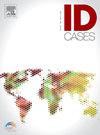Speckled-egg staining appearance of cryptococcal osteomyelitis in an immunocompetent patient
IF 1
Q4 INFECTIOUS DISEASES
引用次数: 0
Abstract
Introduction
Cryptococcal infections are typically thought of as occurring in immunocompromised patients, such as patients with HIV/AIDS, solid organ transplant recipients, or patients with rheumatologic diseases that require immunomodulatory therapy. Moreover, Cryptococcus spp. classically appear as variably-sized yeasts with narrow-based budding surrounded by a thick polysaccharide capsule. However, cryptococcal infections are being increasingly reported in atypical hosts, at times with non-characteristic histochemical staining appearances. Herein, we report a case of cryptococcal osteomyelitis in an otherwise immunocompetent individual that had a “speckled-egg” staining appearance on direct-smear Gram stain.
Case
The patient is an otherwise healthy 89-year-old male with a past medical history notable only for hypertension who presented with progressive left-sided neck pain that became worse despite lidocaine trigger point injections; imaging was obtained and revealed a C1-C2 prevertebral abscess, C2-C4 osteomyelitis, and a small C2-C4 abscess. An aspiration biopsy from one of the cervical abscesses grew Cryptococcus neoformans. Despite prompt initiation of liposomal amphotericin B as soon as the organism was suspected, the patient’s mentation declined with associated progression of weakness in his upper and lower extremities. The patient was ultimately transitioned to comfort care.
Conclusions
Unconventional presentations of cryptococcal disease are becoming increasingly recognized in seemingly immunocompetent patients. Our case was unique given that it occurred in a patient who appeared to be immunocompetent and the Gram stain showed a speckled-egg staining pattern that alone was not distinctive for cryptococcal yeasts. Despite the patient’s lack of any classic comorbidities associated with invasive cryptococcal disease, his advanced age was likely a risk factor.
免疫功能正常患者隐球菌性骨髓炎的斑点卵染色外观
隐球菌感染通常被认为发生在免疫功能低下的患者中,如HIV/AIDS患者、实体器官移植接受者或需要免疫调节治疗的风湿病患者。此外,隐球菌属典型地表现为大小不一的酵母,芽殖狭窄,周围有厚厚的多糖胶囊。然而,隐球菌感染在非典型宿主中的报道越来越多,有时表现为非特征性的组织化学染色。在此,我们报告一例隐球菌性骨髓炎,在其他免疫功能正常的个体中,直接涂片革兰氏染色呈“斑点蛋”样染色。病例:患者为89岁男性,其他方面健康,既往仅有高血压病史,表现为进行性左侧颈部疼痛,尽管利多卡因触发点注射后仍加重;影像学显示C1-C2椎前脓肿、C2-C4骨髓炎和一个小的C2-C4脓肿。一个宫颈脓肿的穿刺活检发现新型隐球菌。尽管在怀疑感染时立即开始使用两性霉素B脂质体,但患者的精神状态下降,并伴有上肢和下肢无力的相关进展。病人最终被转移到舒适护理。结论隐球菌病的非常规表现在免疫功能正常的患者中得到越来越多的认识。我们的病例是独特的,因为它发生在一个似乎具有免疫能力的患者身上,革兰氏染色显示有斑点的卵状染色模式,而这种模式单独对隐球菌酵母来说并不独特。尽管患者没有任何与侵袭性隐球菌病相关的典型合并症,但他的高龄可能是一个危险因素。
本文章由计算机程序翻译,如有差异,请以英文原文为准。
求助全文
约1分钟内获得全文
求助全文

 求助内容:
求助内容: 应助结果提醒方式:
应助结果提醒方式:


